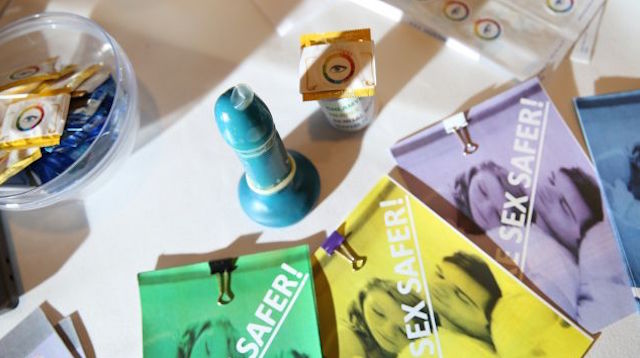When the TeenTech Awards announced their 2015 winners last week, news outlets far and wide swooned over the concept of colour-changing condoms that detected STDs proposed by three teenaged students. The idea is brilliant as it is bizarre — but don’t expect to see these in stores anytime soon.
This should not come as a surprise: The TeenTech Awards is an ideas fair. This is not the Intel Science Talent Search. It’s aimed at younger students, with the goal of sparking their interest in the sciences — to that end, projects are supposed to “identify an opportunity or a problem, suggest a solution and research the market.” The idea is to get kids thinking about science and engineering as a way to solve problems. Teams aren’t asked to do the experiments to find out whether their idea will actually work.
The technical and ethical challenges for this product are significant. The students, Daanyaal Ali, Chirag Shah, and Muaz Nawaz from Isaac Newton Academy in London, told the BBC that they got the idea for their colour-changing condom, called the S.T.EYE, when they learned about ELISA tests. ELISAs — enzyme-linked immunosorbent assays — are a multi-step testing process that can determine whether a person is carrying antibodies to a particular disease. The students proposed a condom with a group of ELISA-style tests embedded inside it, to test for chlamydia, genital warts, syphilis and herpes. The condom would turn a different colour for each infection.
Now, I do a lot of immunocytochemistry when I’m wearing my scientist hat: those methods of analysing cells work on the same basic principles as an ELISA test. So when I read the students’ proposal for their product, I knew that they were going to have to solve enormous technical problems if it were ever to work.
Antibodies are certainly present in both semen and vaginal secretions. But for this test to work, it would need to find a way to make antibodies from specific diseases bind to the condom. That’s not a conceptual challenge: each test needs to screen for antibodies that attach to proteins that are only found on one kind of infectious organism. Finding those unique proteins to put in the test? That’s a much bigger challenge. Nevertheless, there are some sexually transmitted diseases — chlamydia, gonorrhea, trichomoniasis — that can now be detected with antibody-based tests, so it isn’t impossible.
Getting the antibody from an infected person to bind to the antigen on the test strip is just the first step. The reaction is still invisible until you add a dye. How do you get a dye to attach to an antibody? You need to add another antibody.
This “secondary” antibody has a dye molecule attached to one end. Its other end can bind to any other antibody made inside one particular type of animal: either all rabbits, or chickens, or goats, or mice, you get the idea. The result, in a staining protocol, is a sandwich-like chain with two antibodies crammed between the antigen and the dye that announces the reaction to the world.
That’s all for one test. At a minimum, any company pursuing this idea would have to figure out a way to embed those steps into the plastic they make the condom from. If they could do that, they would also have to find a way to make the condom absorbable enough to test a little semen or vaginal fluid without becoming so porous that it let those fluids seep all the way through. Multiple layers might work, but in general, condom manufacturers are trying to find ways to make their product thinner and stronger, not partly porous.
To put multiple tests with multiple dyes into one condom is even more of a technical nightmare. In the lab, it’s possible to stain more than one protein at a time using different dyes, but it’s a delicate operation — you need to use antibodies raised in different species to avoid cross-reactions and false positives. In a condom, all the first line of antibodies would be human ones, and the secondary antibodies, each carrying a different dye, wouldn’t be able to tell them apart. One possible solution might be to put discrete test spots all around the condom, each one specific to a different kind of infection.
I wanted to ask the students who developed the condom idea whether they had any thoughts about the technical problems they would face if they tried to turn their idea into reality. Unfortunately, they’d stopped taking interviews. That, in a way, made me sad. The goal of the TeenTech Awards is to spark interest in the sciences, but doing science involves much more than just having interesting ideas. I hope the international attention, and help from their teachers, encourages them to learn how to rigorously test their ideas against the cold, hard edges of reality. Technical problems, after all, can be solved.
[Forbes, CDC]
Picture: TeenTech
